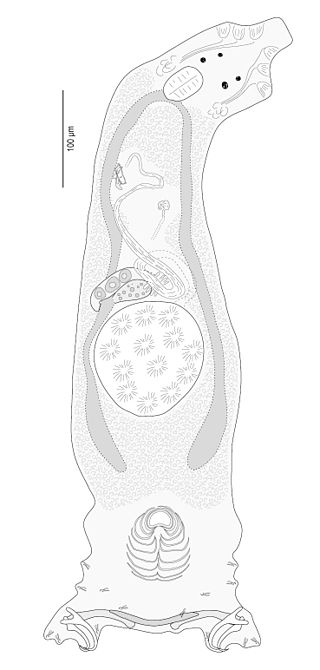Isospora is a genus of internal parasites in the subclass Coccidia.
Plasmodium percygarnhami is a parasite of the genus Plasmodium subgenus Vinckeia. As in all Plasmodium species, P. percygarnhami has both vertebrate and insect hosts. The vertebrate hosts for this parasite are mammals.

Onchocerca is a genus of parasitic roundworm. It contains one human parasite – Onchocerca volvulus – which is responsible for the neglected disease Onchocerciasis, also known as "river blindness" because the infected humans tend to live near rivers where host black flies live. Over 40 million people are infected in Africa, Central America, and South America. Other species affect cattle, horses, etc.
Tetrameridae is a family of spirurian nematodes. It is the smallest of the large genera making up the bulk of the superfamily Habronematoidea. Like all nematodes, they have neither a circulatory nor a respiratory system. They are parasites, chiefly of birds and cetaceans.

Pterygodermatites is a genus of parasitic nematodes in the family Rictulariidae. Their life-cycle is complex. Species include:

Microcotyle is a genus which belongs to the phylum Platyhelminthes and class Monogenea. Species of Microcotyle are ectoparasites that affect their host by attaching themselves as larvae on the gills of the fish and grow into adult stage. This larval stage is called oncomiracidium, and is characterized as free swimming and ciliated.

Snake blenny is a fish species in the family Ophidiidae. It is widespread in the eastern Atlantic from southern England to Senegal in West Africa, and the northern Mediterranean. It is a marine subtropical demersal fish, up to 25 centimetres (9.8 in) long.

Pseudorhabdosynochus is a genus of monopisthocotylean monogeneans, included in the family Diplectanidae. The type-species of the genus is Pseudorhabdosynochus epinepheli .

The Capsalidae is a family of monopisthocotylean monogeneans, which includes about 200 species.

Louis Euzet was a French parasitologist.

Pseudorhabdosynochus beverleyburtonae is a diplectanid monogenean parasitic on the gills of the dusky grouper, Epinephelus marginatus. It has been described by Guy Oliver in 1984 as Cycloplectanum beverleyburtonae, redescribed by Oliver in 1987, transferred to the genus Pseudorhabdosynochus by Kritsky & Beverley-Burton in 1986 as Pseudorhabdosynochus beverleyburtonae, redescribed by Kritsky, Bakenhaster and Adams in 2015, and redescribed in 2016 by Chaabane, Neifar, Gey & Justine.
Hexabothriidae is a family of monogenean parasites. The family name was proposed by Emmett W. Price in 1942. The family includes 14-16 genera according to authors and about 60 species; all are parasitic on the gills of chondrichthyan fishes.

Echinoplectanum is a genus of monopisthocotylean monogeneans in the family Diplectanidae. All its species are parasites on the gills of fish; hosts recorded to date are all groupers, including coralgroupers and the Dusky grouper. So far, species of Echinoplectanum have been recorded only from fish caught off Australia, New Caledonia and in the Mediterranean Sea.

Lamellodiscus is a genus of monopisthocotylean monogeneans in the family Diplectanidae; all species of Lamellodiscus are small worms, parasitic on the gills of teleost fish.
Pseudorhabdosynochus caballeroi is a diplectanid monogenean parasitic on the gills of fish. It has been described in 1984 by Guy Oliver. The name of the species honours Professor Eduardo Caballero y Caballero, a Mexican parasitologist.

Microcotyle donavini is a species of monogenean, parasitic on the gills of a marine fish. It belongs to the family Microcotylidae.
Microcotyle erythrini is a species of monogenean, parasitic on the gills of a marine fish. It belongs to the family Microcotylidae. This species was described by Van Beneden & Hesse in 1863 and redescribed by Parona & Perugia in 1890.
Protolamellodiscus is a genus of monopisthocotylean monogeneans in the family Diplectanidae. All species of Protolamellodiscus are parasites of marine perciform fishes of the families Lethrinidae, Nemipteridae, Serranidae and Sparidae.
Atriasterinae is a subfamily within family Microcotylidae and class Monogenea. This subfamily was created by Maillard & Noisy in 1979.

Robert-Philippe Dollfus was a French zoologist and parasitologist.











